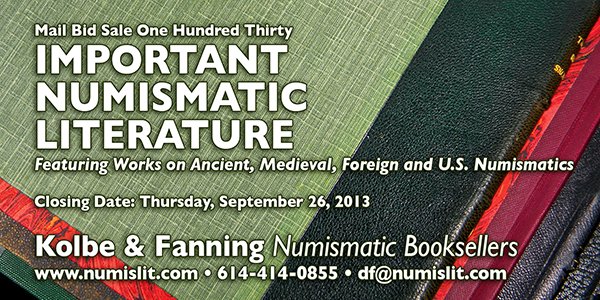
PREV ARTICLE
NEXT ARTICLE
FULL ISSUE
PREV FULL ISSUE
MORE ON SILVER PLUGS IN SILVER COINS
Last week John Dannreuther mentioned an article Chris Pilliod just wrote about the research he did on a 1795 dollar in the most recent issue (August 2013) of
Longacre's Ledger, the Fly-In Club journal. With permission, here's an excerpt from that article. Thanks to Michael Sullivan for the suggestion, John Dannreuther for putting us in touch with Chris Pilliod, and Chris Pilliod for sending a copy of the article.
-Editor
The dealer friend of mine assured me that indeed the piece was a silver plug and it belonged to an elderly woman who traveled to Europe in the 1960’s. There she befriended a man who gave her and her daughter each a silver dollar. Her daughter received a Seated or Trade Dollar which was long gone but she hung on to the Bust Dollar she was given until now. With her house needing mending she was deciding to finally sell it. Being wary of its veracity I gave him some diagnostics to check for on a truly plugged dollar visa-vis a repaired piece. The following week he called and said “it’s in my case”, so I whistled back up to the flea market where he sets up on Wednesdays for an in-person look. And sure enough not only was it truly a silver plugged dollar but also it was a very nice example of one. A Fine 15 or VF20 example with not only a silver plug but one of the most visual silver plugs I have ever seen. Unfortunately some light graffiti was scribed across the obverse “ W.H. Davis Elmira, NY”. But the graffiti is contemporary, lightly engraved and has toned nicely with the natural patina of the coin. Interestingly, parts of the graffiti were scribed over the plug itself. After each planchet was individually weighed the heavy ones were simply filed into specification and struck as-filed, leaving behind what are known as “Adjustment Marks”. Examples of adjustment marks on early US silver and gold issues are ubiquitous. What to do with underweight planchets was a whole different paradigm, as augmenting weight is much taller task than grabbing a hasp and filing away a few grains. But examples exist, most notably on Bust Silver Dollars like my example shown, and to a much lesser extent Bust Half Dollars. The earliest known example is a 1794 Silver Dollar which recently auctioned off for a record $10 Million through a Stacks Bowers Auction. To date it is not known on gold issues. Augmenting weight on a single planchet was at the very least a cumbersome ordeal, a labor intensive procedure that by today’s manufacturing standards view would be considered simply laughable in scope. But in the early Mint days it is now known that underweight blanks would be re-directed to a Mint technician who would then pierce from the center of the blank a hole, measuring roughly 5 mm in diameter. At his disposal were various silver strips, all of thicker but varying gauges (thicknesses), allowing him a selection to punch a perfect plug that upon successful insertion would bring the planchets weight into specification. The same mandrel that was employed to blank out the hole of the planchet was employed to punch the strip used for augmentation. The technician would then manually insert the plug into the planchet, most likely with the use of a simple hammer. The thickness of the plug selected was based on how much underweight the planchet was—the more underweight the heavier the gauge strip selected. In some cases the plug is known to be just slightly heavier than the holed area. In other cases the plug is significantly thicker than the existing planchet. In these cases it is observed that after successful insertion the silver plug was then hammered down to lay flat with the planchet surface to accommodate future striking. A plug that sticks well above the surface of the planchet would render it impossible to strike. There was a time when the silver plugged dollars of 1795 were considered an undesirable anomaly, a difficult sale to the collector—but no longer. In today’s market silver plugged dollars are in ready demand and bring multiples of the standard issue. The example was subjected to a number of metallurgical evaluations to help shed light on its nature. The results clearly showed that the silver content of the plug was virtually identical to the host coin itself, so the reason for the plugging was clearly not the fineness level of the host coin. A scan showing actual silver content of the area just left of the plug and then through the seam and into the plug itself is shown in the attached graph. The large dip in silver content corresponds to the seam.

We then subjected the coin to a 3-D X-ray imaging analysis, and although I do not have the images to share at this time the plug’s morphology is very similar to a rivet; the outside diameter of the plug being 10mm and the center core diameter being 5mm, suggesting a long plug was hammered into place to add weight to a light blank. Although the theme of this letter is not our beloved copper Indian or Flying Eagle, it is a great example of history, numismatics and researching coming together for a fascinating study. To read the earlier E-Sylum article, see: ON SILVER PLUGS AND SILVER COINS (www.coinbooks.org/esylum_v16n36a21.html)

Wayne Homren, Editor The Numismatic Bibliomania Society is a non-profit organization promoting numismatic literature. See our web site at coinbooks.org. To submit items for publication in The E-Sylum, write to the Editor at this address: whomren@gmail.com To subscribe go to: https://my.binhost.com/lists/listinfo/esylum All Rights Reserved. NBS Home Page Contact the NBS webmaster 
|